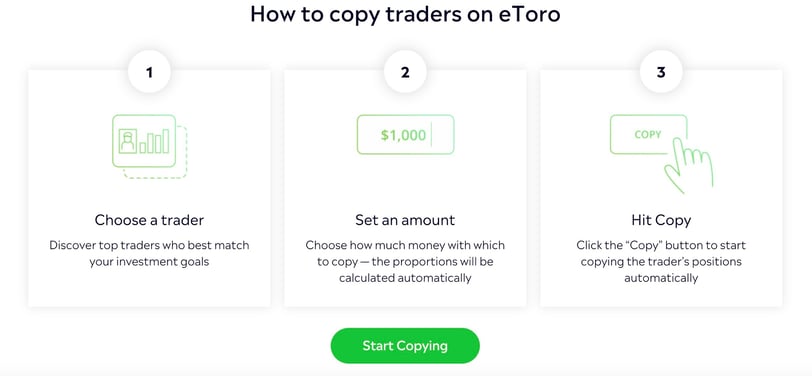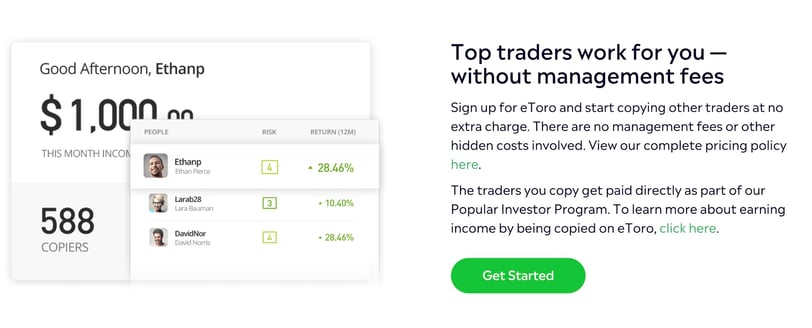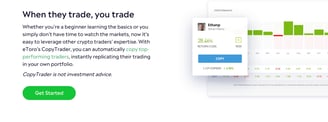Copy Trading on eToro: A Beginner's Guide
Learn how to Copy Trading with eToro. Simple Strategies, Easy to Follow
By: SFTopNews Editors


Copy trading makes it possible. It's true!
With eToro's innovative copy trading feature, you can follow the footsteps of successful traders and potentially earn significant profits.
No longer do you need to spend countless hours analyzing charts, researching market trends, or making complex trading decisions.
Copy trading allows you to automatically replicate the trades of experienced investors, even if you have little to no trading experience.
By copying the strategies of top traders, you can potentially benefit from their expertise and achieve consistent returns.
Whether you're a seasoned investor or just starting your financial journey, copy trading offers a convenient and accessible way to participate in the market.
Want to Start Earning Like A Pro Trader?
Understanding Copy Trading
What is Copy Trading?
Copy trading is a method where you can automatically replicate the trades of experienced investors, known as "Copy Traders." This means that when a Copy Trader buys or sells an asset, your account will automatically mirror those actions.
How Does Copy Trading Work on eToro?
Choose a Copy Trader: On eToro, you can browse a vast database of Copy Traders, each with their own trading history, risk profile, and performance metrics.
Allocate Funds: Once you've selected a Copy Trader, you can allocate a portion of your trading capital to their account. This amount will be used to copy their trades.
Automatic Replication: As the Copy Trader makes trades, your account will automatically mirror those actions, buying or selling the same assets in the same proportions.
Benefits of Using Copy Trading
Accessibility: Copy trading makes investing in financial markets accessible to people with limited trading experience or time.
Convenience: It eliminates the need for constant market monitoring and decision-making.
Potential for Profit: By copying successful traders, you can potentially achieve higher returns than you might on your own.
Risk Management: Many Copy Traders have developed effective risk management strategies that can benefit those who follow them.
Learning Opportunity: Observing the trading strategies of experienced investors can be a valuable learning experience.
Important Considerations
Past Performance: While past performance is a helpful indicator, it doesn't guarantee future results.
Risk Tolerance: Ensure that the Copy Trader's risk profile aligns with your own.
Diversification: Consider diversifying your investments by copying multiple traders or using a combination of copy trading and your own trading.
Selecting the Right Traders
Performance History
Track Record: Look for traders profile ( LINK ) with a consistent and profitable track record over a significant period.
Risk-Adjusted Returns: Consider the Sharpe ratio, which measures risk-adjusted returns. A higher Sharpe ratio indicates better risk-adjusted performance.
Drawdown: Analyze the maximum drawdown, which is the largest percentage decline from a peak to a trough. A lower drawdown suggests better risk management.
Risk Tolerance
Trading Style: Determine the trader's risk tolerance based on their trading style. For example, a high-frequency trader may be more risk-tolerant than a value investor.
Leverage: Assess the amount of leverage the trader uses. Higher leverage can amplify both gains and losses.
Stop-Loss Orders: Check if the trader consistently uses stop-loss orders to limit potential losses.
Trading Strategy
Investment Philosophy: Understand the trader's underlying investment philosophy. Are they a fundamental analyst, technical analyst, or a combination?
Asset Classes: Determine the asset classes the trader focuses on (e.g., stocks, forex, commodities).
Frequency of Trades: Consider the trader's trading frequency. Some traders may make frequent trades, while others may hold positions for longer periods.
Tips for Evaluating Copy Traders' etoro Profiles and Analyzing Past Trades
Check for Certifications: Look for traders with relevant certifications, such as the Chartered Financial Analyst (CFA) designation.
Read Reviews and Comments: Pay attention to feedback from other investors who have copied the trader.
Analyze Trade History: Use eToro's tools to analyze the trader's past trades, including their entry and exit points, profit/loss, and holding periods.
Consider Diversification: Don't put all your eggs in one basket. Copy multiple traders to diversify your risk.
Stay Informed: Keep up-to-date with the trader's performance and any changes in their trading strategy.
By carefully considering these factors and following these tips, you can increase your chances of selecting successful traders to copy on eToro.
Remember that past performance is not a guarantee of future results, and it's always important to do your own research and exercise caution.
Managing Your Copy Trading Portfolio
Diversification: A Key Strategy
Multiple Traders: Copying multiple traders with different investment styles and risk profiles can help spread your risk and reduce the impact of individual trader performance fluctuations.
Asset Classes: Consider diversifying across different asset classes (e.g., stocks, forex, commodities) to mitigate risks associated with specific market sectors.
Monitoring and Adjustments
Regular Reviews: Monitor your copied trades regularly to assess their performance and identify any potential issues.
Performance Analysis: Use eToro's tools to analyze the performance of individual traders and your overall portfolio.
Risk Assessment: Continuously evaluate the risk associated with each trader and adjust your allocations accordingly.
Adjustments: If a trader's performance deteriorates or their strategy changes, consider reducing or eliminating your allocation to their account.
Rebalancing: Periodically rebalance your portfolio to ensure that your allocations align with your risk tolerance and investment goals.
Potential Risks and Mitigations
Counterparty Risk: The risk that the Copy Trader may default on their obligations. Mitigate this by copying reputable traders with a strong track record.
Market Risk: The risk of overall market declines. Diversification and careful risk management can help mitigate market risk.
Operational Risk: The risk of technical issues or errors in the copy trading process. Choose a reputable platform like eToro with robust systems in place.
Emotional Bias: Avoid making impulsive decisions based on short-term market fluctuations. Stick to your long-term investment plan.
Effective portfolio management in copy trading involves diversification, regular monitoring, and risk mitigation. By following these guidelines, you can maximize the benefits of copy trading while minimizing potential risks.
Maximizing Your Returns in Copy Trading
Optimizing Your Strategy
Research and Due Diligence: Continuously research potential traders, analyze their performance history, and understand their trading strategies.
Risk Tolerance: Ensure that the traders you copy align with your risk tolerance. Avoid copying traders who engage in excessively risky behavior.
Diversification: Spread your investments across multiple traders to reduce risk and increase potential returns.
Monitor and Adjust: Regularly review the performance of the traders you copy and make adjustments as needed.
Learn from the Best: Observe the trading strategies of successful traders to improve your own understanding of the markets.
Setting Realistic Expectations
Avoid Get-Rich-Quick Schemes: Understand that copy trading is not a guaranteed path to wealth. It requires patience, discipline, and risk management.
Realistic Returns: Set realistic expectations for your returns. Past performance is not indicative of future results.
Time Horizon: Consider your long-term investment goals and time horizon. Copy trading may be more suitable for investors with a longer-term perspective.
Managing Your Risk
Stop-Loss Orders: Use stop-loss orders to limit your potential losses in case a trade moves against you.
Take-Profit Orders: Set take-profit orders to lock in profits when a trade reaches your target price.
Position Sizing: Carefully manage your position size to avoid excessive risk.
Risk-Reward Ratio: Focus on trades with a favorable risk-reward ratio, where the potential reward outweighs the risk.
Advanced Features
Stop-Loss and Take-Profit Orders: These orders can help protect your profits and limit your losses.
Trailing Stop: A trailing stop automatically adjusts the stop-loss price as the trade moves in your favor, helping to capture more profits.
Risk Management Tools: Many platforms offer advanced risk management tools, such as portfolio margin and hedging, to help you manage your overall risk exposure.
By following these tips and utilizing advanced features.
You can optimize your copy trading strategy and increase your chances of maximizing returns while managing risk effectively.
Remember, success in copy trading requires a combination of research, patience, and disciplined risk management.
Conclusion
Copy trading offers a convenient and potentially profitable way to invest in financial markets. By following experienced traders, you can benefit from their expertise and potentially achieve higher returns than you might on your own.
Key Points Discussed in this post Include:
Understanding Copy Trading: How it works and the benefits it offers.
Selecting the Right Traders: Factors to consider when choosing traders to copy.
Managing Your Portfolio: Diversification, monitoring, and risk management strategies.
Maximizing Returns: Tips for optimizing your copy trading strategy and setting realistic expectations.
The Pros And Cons : Fees Social Features
If you're looking for a way to invest in financial markets without the need for extensive research or analysis, copy trading may be a suitable option for you.
Selecting traders, managing your risk, and setting realistic expectations, you can increase your chances of achieving your investment goals.


Pros and Cons of Copy Trading on eToro
Pros of Copy Trading on eToro:
Accessibility: Copy trading makes investing more accessible to beginners who may be intimidated by the complexities of the financial markets.
Diversification: By copying multiple investors, you can diversify your portfolio and reduce risk.
Learning Opportunity: Observing the trades of successful investors can help you learn about different investment strategies and market trends.
Potential for High Returns: If you choose to copy the trades of highly skilled investors who consistently outperform the market, you could potentially achieve significant returns.
Cons of Copy Trading on eToro:
Lack of Control: When you copy another investor's trades, you relinquish control over your investment decisions. This means you may not fully understand the underlying reasons for the trades or the risks involved.
Performance Risk: The performance of the investor you're copying can fluctuate. If their performance declines, your investments may also suffer.
Fees: eToro charges a spread on each trade, which can impact your overall returns.
Risk of Following a Bad Investor: There's a risk of following an investor who is making poor investment decisions. This could lead to significant losses.
Key Considerations:
Research: Before copying an investor, do your due diligence to understand their investment strategy, track record, and risk tolerance.
Diversify: Don't put all your eggs in one basket. Copy multiple investors to diversify your portfolio and reduce risk.
Set Limits: Establish clear stop-loss and take-profit levels to manage your risk and protect your investments.
Be Patient: Investing is a long-term game. Don't expect immediate results and be prepared to ride out market fluctuations.
Whether copy trading on eToro is right for you depends on your individual circumstances and risk tolerance.
If you're a beginner or lack the time to actively manage your investments, copy trading can be a viable option.
However, it's important to approach it with caution and conduct thorough research before making any investment decisions.
Disclaimer: The information provided on SFTopNews is for general informational purposes only and does not constitute financial advice. We strive to provide accurate and up-to-date information, but we cannot guarantee the accuracy or completeness of the content
Investors should conduct their own research and consult with a qualified financial advisor before making any investment decisions. Past performance is not indicative of future results.
SFTopNews is not responsible for any losses or damages arising from reliance on the information presented on this website.
FAQs on eToro Copy Trading
What factors should I consider when choosing copy trader to follow?
Look at their performance history, risk tolerance, trading frequency, and the types of assets they invest in. Consider their overall strategy and whether it aligns with your investment goals.
How can I assess an Copy Trader's performance?
Track Record:
Profitability: Look at the trader's overall profit and loss (P&L) over different time periods.
Consistency: Assess whether the trader consistently generates profits or experiences significant drawdowns.
Risk-Adjusted Returns: Consider the Sharpe ratio, which measures risk-adjusted returns. A higher Sharpe ratio indicates better risk-adjusted performance.
Does eToro Copy Trader' Get Paid ?
No, eToro copy traders do not get paid directly by the platform. They earn profits from their own trading activities, just like any other investor
Is there a fee for copy trading on eToro?
Yes, there is a fee associated with copy trading on eToro. The fee is charged as a spread, which is the difference between the buy and sell price of an asset. This spread is typically higher than the spread for regular trading.
Is Copy Trading Legal in US ?
Yes, copy trading is legal in the United States. As long as the platform you're using is registered with the Securities and Exchange Commission (SEC) and complies with U.S. securities laws, copy trading is generally considered a legitimate investment strategy
What is the Minimum Deposit to Copy Trade on eToro?
The minimum deposit required to copy trade on eToro varies depending on your location and the specific regulations in your region. However, in general, the minimum deposit is typically around $100 to $200 USD






